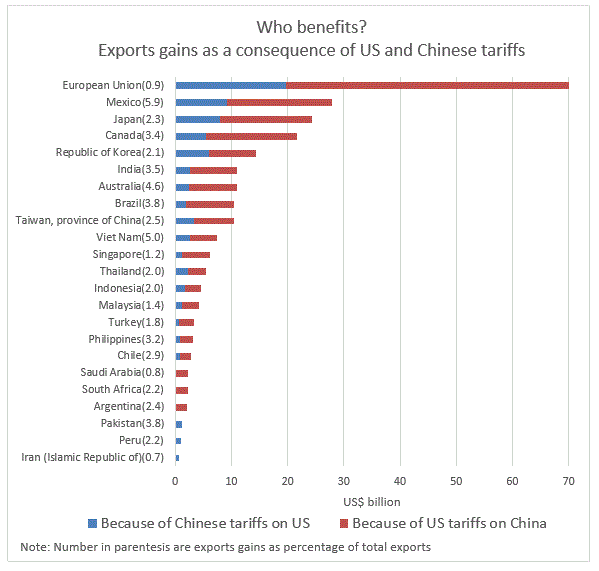E.U. to Benefit Most from Trade War
Of the $250 billion in Chinese exports subject to U.S. tariffs, about 82 percent will be captured by firms in other countries, about 12 percent will be retained by Chinese firms and only about six percent captured by U.S. firms.
That is according to a new study Key Statistics and Trends in Trade Policy 2018 by UNCTAD.
Similarly, of the approximately $110 billion in U.S. exports subject to China’s tariffs, about 85 percent will be captured by firms in other countries, U.S. firms will retain less than 10 percent, while Chinese firms will capture only about five percent. The results are consistent across different sectors, from machinery to wood products, and furniture, communication equipment, chemicals to precision instruments.
The reason is simple: bilateral tariffs alter global competitiveness to the advantage of firms operating in countries not directly affected by them. Countries that are expected to benefit the most from U.S.-China tensions are those which are more competitive and have the economic capacity to replace U.S. and Chinese firms. The study indicates that European Union exports are those likely to increase the most, capturing about $70 billion of U.S.-China bilateral trade ($50 billion of Chinese exports to the U.S., and $20 billion of U.S. exports to China). Japan, Mexico and Canada will each capture more than $20 billion.
Although these figures do not represent a large slice of global trade – which was worth about $17 trillion in 2017 – for many countries they make up a substantial share of exports. For example, the approximately $27 billion of U.S.-China trade that would be captured by Mexico represents a non-negligible share of Mexico’s total exports (about six percent).
Substantial effects relative to the size of their exports are also expected for Australia, Brazil, India, Philippines, Pakistan and Vietnam.

However, the study also underscores that even for countries whose exports are set to increase because of the trade sparring, not all the results will be positive. The soybean market is a case in point. Chinese tariffs on U.S. soybeans have resulted in distortions to the advantage of several exporting countries, in particular Brazil, which suddenly became the main supplier of soybeans to China. But because the magnitude and duration of tariffs is unclear, Brazilian producers have been reluctant to make investment decisions that may turn out to be unprofitable if the tariffs are revoked. Moreover, Brazilian firms operating in sectors using soybeans as inputs – such as livestock feed — are bound to lose competitiveness because of price rises stoked by Chinese demand for Brazilian soybeans.
The study underlines that while some countries will see a surge in their exports, negative global effects are likely to dominate. A common concern is the unavoidable impact that trade disputes will have on the still fragile global economy. An economic downturn often accompanies disturbances in commodity prices, financial markets and currencies, all which will have important repercussions for developing countries. One major concern is the risk that trade tensions could spiral into currency wars, making dollar-denominated debt more difficult to service.
Another worry is that more countries may join the fray and that protectionist policies could escalate to a global level. As protectionist policies generally hurt weaker countries the most, a well-functioning multilateral trading system able to defuse protectionist impulses and maintain market access for poorer countries is crucial, states the report.
Finally, in an interconnected global economy, the tit for tat moves of the trade giants are likely to have a domino effect beyond the countries and sectors targeted. Tariff increases penalize not only the assembler of a product, but also suppliers along the chain. For example, the high volume of Chinese exports affected by U.S. tariffs is likely to hit East Asian value chains the hardest, with UNCTAD estimating that they could contract by about $160 billion.
The ongoing trade tensions initially came to a head in early 2018 when China and the U.S. imposed tariffs on about $50 billion of each other’s goods. The confrontation quickly escalated, and in September 2018 the U.S. imposed 10 percent tariffs covering about $200 billion of Chinese imports, to which China retaliated by imposing tariffs on imports from the U.S. worth an additional $60 billion. The 10 percent tariffs were initially due to rise to 25 percent in January 2019. However, in early December 2018 the parties agreed to freeze the tariff increase until March 1, 2019.
